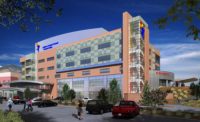The list of the largest projects that broke ground in 2016 is reflective of the growing economic diversity of most states in the Mountain States region. Areas that have been heavily dependent upon the energy sector, especially coal mining and oil-and-gas revenue, are pushing to balance their economic base.
This year’s ranking reveals a nearly even split between public- and private-sector work, with large projects launched in the health care, hospitality, transportation, higher education, office and mixed-use multifamily sectors. Projects for new and renovated government buildings also made this year’s list, led by the $222.7-million makeover of the Wyoming Capitol in Cheyenne, new offices for the Salt Lake County district attorney and an eight-story office tower for the Provo 4th District Courthouse in Provo, Utah.
“2016 was a pretty good year. Most of the contractors, subs and suppliers are busy, and they are optimistic,” says Rich Thorn, president of the Utah chapter of the Associated General Contractors. He adds that many of his members are busy with large ongoing projects such as the new terminal at the Salt Lake airport, although that was not a 2016 start, and planning for the state’s new prison, which begins this year.
|
ENR Mountain States 2016 Top Starts |
“We have, if not the fastest-growing, then certainly in the top three fastest-growing economies [in the U.S.] here in Utah,” says Natalie Gochnour, chief economist and senior adviser to the Salt Lake Chamber of Commerce. “Our unemployment rate is about 3.5% compared to 4.5% nationally.
“Last year was record-breaking in terms of revenue. We have about 11,000 employees across the country right now in nine offices,” says Rob Moore, CEO of Salt Lake City-based Big-D Construction. His firm is working, along with Kier Construction, on an $82-million contract to build Hardware Village, a mixed-use development on a 7.32-acre site near downtown Salt Lake City.
Topping this year’s regional list is the Yellowstone Club – The Village, a 550,000-sq-ft base village project in which contractor GE Johnson Construction is adding several new residences and amenities to Yellowstone Club, a world-class private resort in Big Sky, Mont. Multiple records for concrete placement have been set on the project, which, with a $312-million construction cost, is one of the largest projects in price and size in the history of Montana.
Other large hospitality projects on the list include the $44-million Fort Collins Hotel and Parking Garage in Fort Collins, Colo., being built by Hensel Phelps Construction, and the $33.6-million DoubleTree Hilton Greeley, Lincoln Park, in Greeley, Colo., also a Hensel Phelps project.
Commercial Work
More than a dozen office and multi-use projects got underway across the region last year, including the $166-million Denver Water Operations Complex Redevelopment, led by Mortenson Construction and RNL Design; the $103-million Charter Communications at Village Center Station II, being built by Adolfson & Peterson Construction; and the $110.8-million 16 Chestnut Office Building in Denver, a Saunders Construction project.
The office sector in Colorado is “fundamentally good, but not booming,” says Michael Leccese, executive director of the Urban Land Institute’s Colorado chapter in Denver. The infrastructure investments the city has made, such as light rail and improved mobility corridors, are “attracting positive interest from developers in general,” he adds.
The bigger concern for Colorado, Leccese says, is the extremely low number of new products being built in the condo market because of the current construction-defects climate, which has made developers wary of building for-sale units. Construction defects litigation is common and relatively easy to initiate under current laws, increasing the risks for all parties involved in the condo market. Leccese estimates that less than 2% to 3% of new multifamily projects are for-sale condos; the rest are all rentals.
“We’re hoping for real reform from the Legislature in this session,” he says. “A lot of people would like to see the condo market come back.”
Cathy Rosset, executive vice president and CEO of the American Institute of Architects Colorado Chapter, said in a statement, “We are most hopeful that Senate Bill 156 will pass, as it contains a number of measures that should provide reasonable alternatives to address construction defects in multifamily buildings before jumping to costly lawsuits.”
However, similar bills have not passed in the past two legislative sessions. Sticking points include the role of homeowners’ associations (HOAs) in construction disputes and the current use of litigation rather than arbitration or alternative dispute resolution when defects arise.
“Everyone [who owns a condo] should get to vote on possible defects, not just the HOA board members,” says Michael Gifford, president and CEO of AGC Colorado. “We’re hopeful, but also realistic about getting a compromise bill. History has been against us so far.”
Mark Latimer, president and CEO of the Associated Builders and Contractors Rocky Mountain Chapter, says that his members support compromise legislation as well. “We want to pass legislation that will get builders and developers to start building for-sale multifamily housing again while still protecting the legal rights of individual homeowners,” Latimer says.
But Rosset cautions that “it may go down to the last week of the legislative session in May, as in past years. Or it could be that we make some progress this year and have to settle for baby steps as we move toward resolving this issue.”
Leccese says that the current risk environment has nearly put a stop to condo conversions as well. “The multifamily market in Denver may be softening a bit,” he says. “But there’s a lot of anticipation to see what the next wave of projects will be. The ability to do [condo] conversions would help a lot.”






